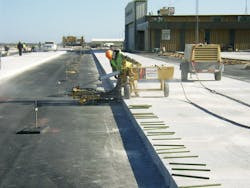When the Kansas National Guard was dealing with the rundown remnants of a World War II-era hangar apron, Pavers Inc. accepted the project. The family-owned business, originally known as Wilson Constructors Inc., has focused on concrete work for more than 60 years. Since 1992 Pavers, Inc moved into municipal/highway contracting, and its skill set now includes concrete pavement, curb and gutter work, and site work such as demolition, grading, treated bases and dirt subgrade.
Repair work, along with an extensive amount of concrete work, is what brought Pavers to the Kansas National Guard project in Salina, Kansas. The mission: Overhaul a 1,000-by-300-foot apron that didn’t drain properly at Army Aviation Support Facility No. 2 at Salina Airport. Pavers needed to mill six inches of old asphalt and concrete and replace it with a fresh concrete overlay.
It’s a mission in which Pavers is well-experienced, says Neal Saskowski, Vice-President of Pavers. “Conservatively, we have done more than 100,000 square yards of pavement patching in the last 15 years,” he remarks.
On average, those jobs range from about 2,000 to 10,000 square yards. That breaks down to 5,000 to 10,000 holes drilled for each project.
Over the years, Pavers’ projects have spanned the gamut, with a specialty focus on airport runways. The Salina airport project for the National Guard had the company facing two feet of concrete and asphalt. The $1.9 million project was bid in the fall of 2010 and work began in November.
A pneumatic advantage
The scope of the project meant sharing responsibilities with other contractors. One contractor did the milling for the top six inches of old concrete and asphalt that needed to come out, while another company was needed to install a 1-inch asphalt bond separation layer. A third major subcontractor provided traffic control, installing barriers around the work area, and doing striping. Pavers focused on the drilling, doweling, and concrete overlay.
“One thing contractors do, is we’ll go out there and see what other contractors are using,” says Saskowski.
The company's observations, as well as Saskowski’s experience in the industry, led the crew to look into options from an Oklahoma-based company called E-Z Drill. When it learned the company’s equipment draws its power from compressed air, they were further intrigued. For Pavers Inc., air compressors were already a standard piece of equipment on the jobsite. With E-Z Drill’s fully pneumatic units, they merely needed to connect the air line and go.
“The pneumatic operation was a big seller for us because we already operate air compressors on the jobsites,” Saskowski said.
Since purchasing its first E-Z Drill in 1990, pavement repair projects have increased significantly for Pavers.
“E-Z Drills are our drills of choice as they meet our production requirements, are fairly easy to maintain, and quite reliable when maintained properly,” Saskowski says.
“Our fleet consists of three-gang, two-gang, and single-gang slab rider drills. We also have three of the Model 210 on-grade drills, a Model 65B [on-grade drill] for small patch work and the vertical attachment to turn a 210 on-grade unit into a vertical drill."
Efficiency; reliability
Two of those slab rider drills helped speed along the Kansas National Guard project to its April 2011 finish date. When Pavers set to work with a crew of some 15-18 employees to reconstruct the apron for the Guard, it divided the 300,000-square foot tarmac area near the hangar into 18, 16-foot-wide lanes, along with a few smaller areas. The company would need to drill more than 32,000 holes to complete the mission, with about 875 holes for each lane edge.
In a day and a half, Pavers could finish four 1,000-foot-long edges, a very high productivity rate, according to Saskowski. The equipment’s reliability prevented any downtime in the process, which consisted of the crew pouring two lanes at a time, then coming back to drill the edges on both before moving to the next lanes.
Pavers employed the E-Z Drill Model 210B-2 SRA, a two-gang slab rider drill, and the Model 210B-3 SRA, a three-gang version, to drill the thousands of 7/8-inch diameter, 18-inch deep holes needed for the project. Once Pavers had each lane’s holes drilled, they epoxied the dowels into place and finished off the lane with concrete.
The tarmac space is used for ten helicopter pads for the Kansas Army National Guard’s UH-60 Black Hawk helicopters. A thicker concrete area allows heavier transport planes, such as the Guard’s KC-135 refueling stratotankers.
Lindsay Babb is the Public Relations Director for IRONCLAD Marketing, Fargo, ND. She can be reached at [email protected] or 701.373.0062.
